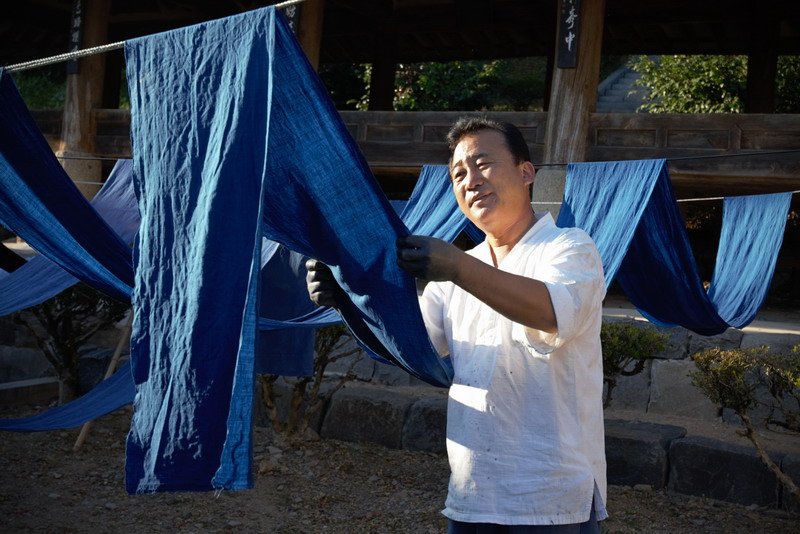Living to Dye: Indigo Master, Jung Kwan-chae
By Kang Jennis Hyun-suk
In this issue, we feature and interview Korea’s only living human cultural asset for fabric dyeing, National Intangible Cultural Asset No. 115, Jung Kwan-chae (정관채). Master Jung’s ancestors long ago settled in Dasi-myeon, a rural area within the Naju city limits south of Gwangju, and Jung has lived there all his life.
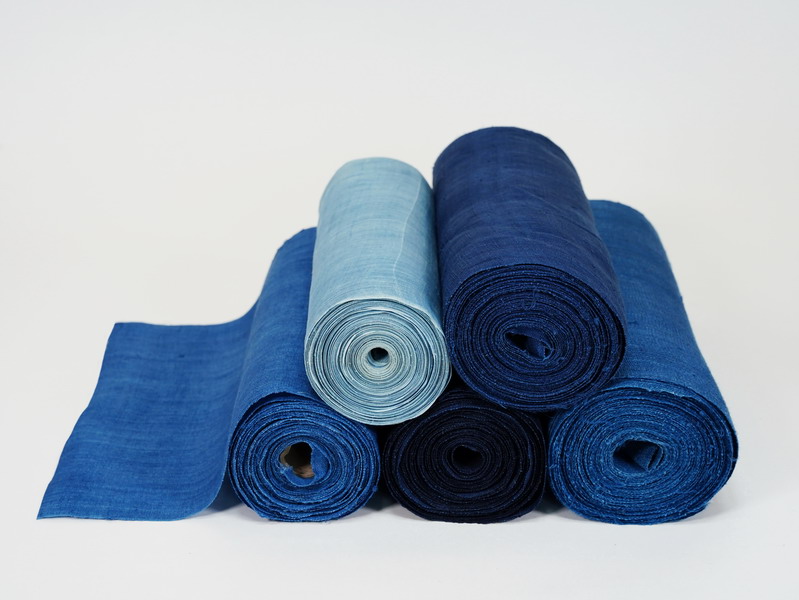
Naju and Korean Indigo
Attesting to the importance of Naju in the Jeolla area is that in the naming of provinces by the Goryeo Dynasty in 1018, the names of the two most important urban areas in the province were combined: the first syllable of “Jeonju” and the first syllable of “Naju” to form “Jeolla.”
The Yeongsan-po district of Naju was once a bustling port (the –po portion of its name means “port.”) It is still known for its street of stingray restaurants. This port was one of the largest, with boats bringing in catches of a variety of seafood and salt from the nearby islands at the mouth of the Yeongsan River. Rich supplies from the islands and vast agricultural plain on the mainland made Naju a powerful city in supporting Wang Geon (왕건, 877–943 A.D.), who founded the Goryeo Dynasty over a thousand years ago. Jung’s home township of Dasi-myeon, though near this plain, was too close to the Yeongsan River to be suitable for rice farming, due to the flooding that occurred annually with the summer rains.
However, Jung’s home village of Saetgol (샛골) was famous for cotton growing because of the warm weather. Cotton fabric was used for making clothes and bedding. Almost all the women of the village had looms at home for weaving fabric and dyeing cloth to make clothes and bedding for themselves. The word for weaving cloth is nai (나이) in Korean, and Saetgol nai (샛골나이) was the epitome of fine cotton cloth across the country.
Persicaria tinctoria (or jjok [쪽], Korean indigo), which was a plant used for dyeing the cotton fabric, was grown along the river. It could be harvested in July or early August, so jjok was less vulnerable to flood damage than growing rice in Saetgol. This made Jung’s home village a mecca for cotton fabric and jjok. In addition, the Yeongsan River was close by, a ready source of oyster shells, which are essential for dyeing fabric. All these conditions made Jung’s village perfect for fabric dyeing.
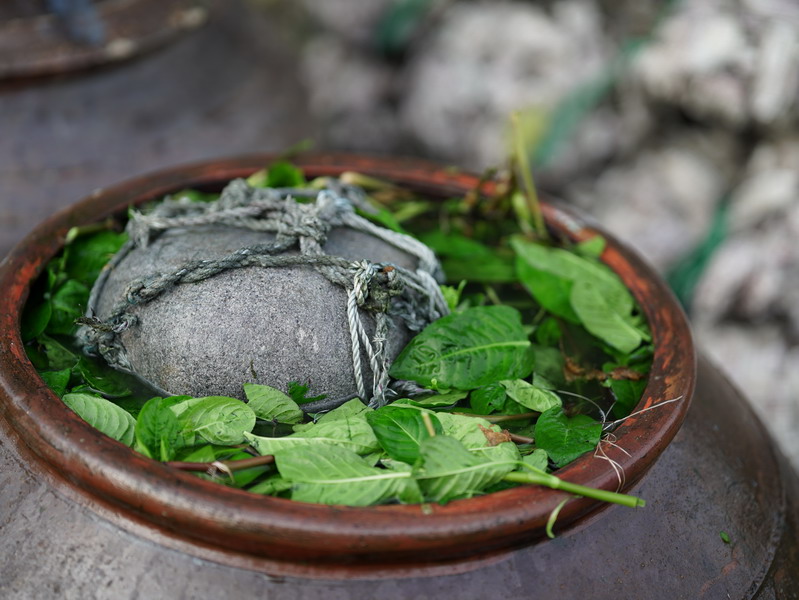
The Tradition Dies Out
Saetgol Village had perfect conditions for growing cotton, weaving, and dyeing, but the times began to change. Naju, which flourished with nearby jjok plantations, became more and more crowded with merchants, some who came from as far as China and Japan, to get dyes and fabrics up until the early 1900s. But after the Korean War, as chemical dyes and synthetic fibers were now in wide use, jjok plantations disappeared and jjok dyeing died out.
Resurrecting the Art of Dyeing
When Jung Kwan-chae was attending Mokpo National University, he majored in fine arts. The professor who taught fabric dyeing, Park Bok-kyu, gave him some Korean indigo seeds. The professor had received the seeds from Ye Yong-hae, a journalist who was searching out and recording human cultural assets. Professor Park told the young, 20-year-old man from Saetgol that he should use the seeds to resurrect jjok dyeing.
After overcoming several failures, Jung succeeded in cultivating jjok and harvesting the leaves to produce dye. He thought to himself, “Who else would resurrect the cultivation of jjok and the tradition of dyeing in this modern society? Though it won’t make me a fortune, I should make it as a descendant of the traditional dyeing village.” Jung has now spent more than 40 years restoring and researching the art of jjok dyeing. And now, in his mid-60s, he is the only human cultural asset for jjok dyeing.
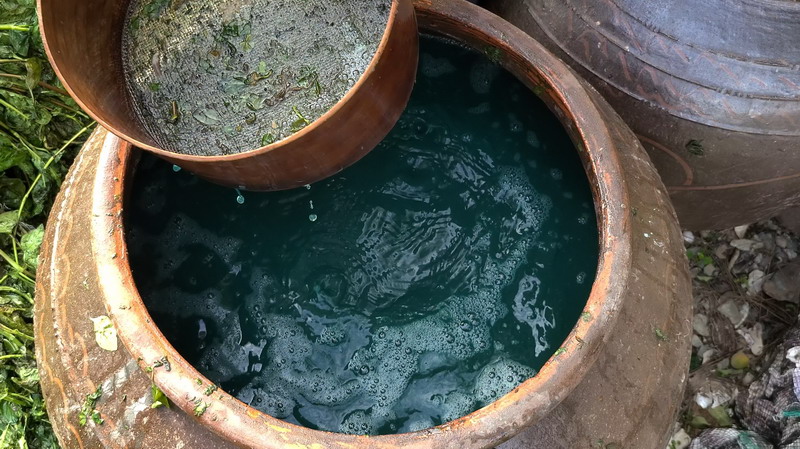
Master Jung’s Traditional Dyeing Center
The day I visited Master Jung’s Traditional Dyeing Center, I spotted a stack of oyster shells piled high and a lot of large pots for the fermentation of jjok in the yard. Some of Jung’s students were dyeing fabrics just as they had learned from their master. I could read the eagerness to learn traditional fabric dyeing in their faces, and I could feel his students were creating vitality in a quiet, rural village.
When I entered the center, Jung was talking with other guests who had come earlier than me. While I was waiting, I could overhear their conversation. I found that the guests were experts on restoring and repairing Korea’s ancient cultural assets, and they had come to ask Master Jung for his help. I knew that natural jjok dyeing had antibacterial properties that protect the fabric from bacteria and insects, but I found out that its antibacterial function could also be used to preserve ancient documents.
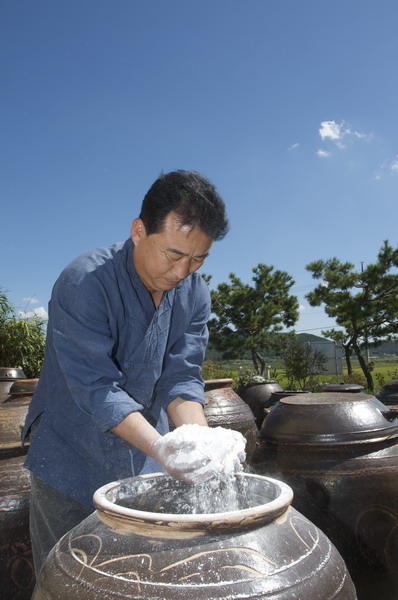
When the document-preservation experts were finished, Master Jung was ready to dive into the interview that both of us had eagerly waited for.
The Interview
Jennis: I heard that you have devoted your life to the revival of jjok dyeing ever since you were a young man. I think the greatest task for a young artist is to create art and, at the same time, generate enough funds to live on. May I ask how you solved the problem?
Master Jung: The busiest season for jjok dyeing is the hottest season of the year. As I majored in art education, I was able to work as an art teacher at a school. During the week, I would teach, and on weekends, I grew jjok. Fortunately, school vacation starts around the same time as the busiest season for jjok dyeing.
Jennis: There is a saying, “Summer in Korea is hot enough to bend a cow’s horns, but jjok dyeing should be done in the hottest season.” Why is that?
Master Jung: Jjok, or indigo, must be harvested before the flower blooms to produce the deepest blue pigment, and this time is right in the middle of summer. When people think of dyeing, they just think of coloring cloth, but it takes more than half a year to prepare for coloring cloth: growing jjok, harvesting it, extracting the dye, and fermenting it. Both harvesting and extracting the dye necessarily take place in the hottest season.
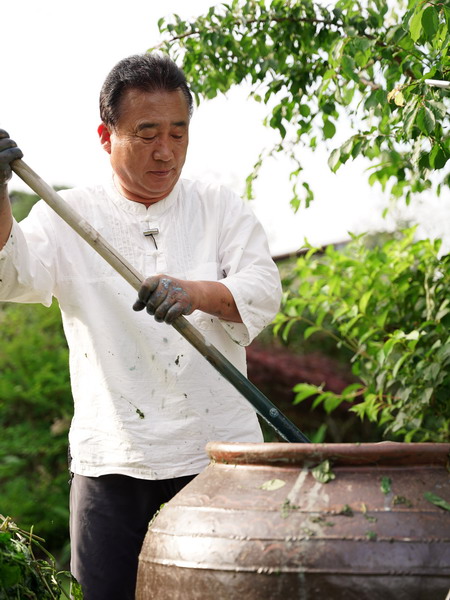
Jennis: People say that jjok is the most difficult dye to extract. I would like to know how to go about making the traditional jjok dye.
Master Jung: Certainly. First, put the harvested jjok in a large earthenware pot and pour in water so that the leaves are submerged. After two or three days, the water turns the color of jade. Then, remove the jjok leaves and add oyster shell powder. Heat the oyster shells in a kiln at over 1,000°C, and then grind them into a powder. The jade water will turn blue and form a navy foam. Third, the pigment is made of the insoluble material that sinks, so after the pigment has settled, pour out the clear water. The thick material that remains is called niram (니람) – the ni means “mud” and ram is “indigo” in Chinese characters. The niram is stored in a pot in a shady, cool place until needed.
Jjok is insoluble, so fermentation is necessary to make it soluble for dyeing. Alkaline lye is used for fermentation, which is made by pouring hot water into a pot of beanstalk ashes. Next, put the lye and niram into a container and mix them well. At this time, make sure that the lye is 8–10 times more than that of the niram. After some time (about a month), blue foam forms on the surface of the liquid, which indicates that it is now ready to use as dye.
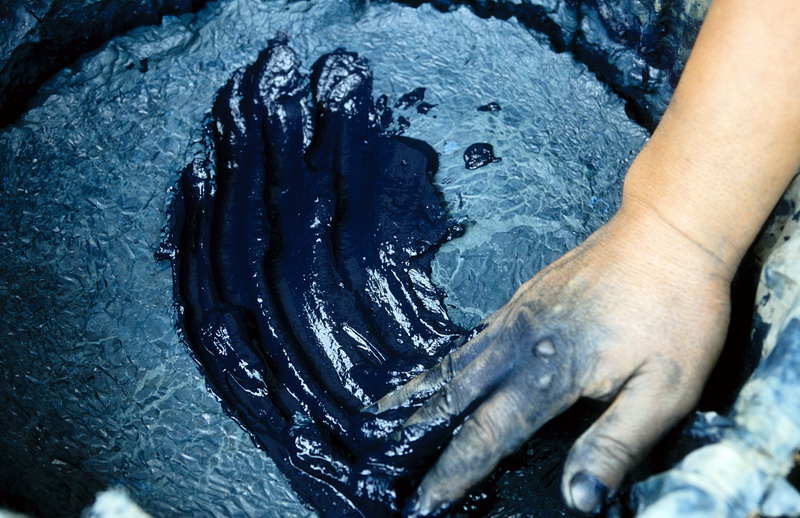
Jennis: It takes more than six months just to prepare the dye material. I think the process of dyeing fabric is just as difficult. How do you go about it?
Master Jung: Each step of the dyeing process requires delicate care. I put my whole mind into it and proceed as I pray because dyeing is only possible if all the conditions are just right. The process goes like this:
—Prepare a cloth by washing it to remove the impurities.
—Put the cloth into the jjok dye liquid, and take it out after 3–5 minutes. The yellowish green turns blue as it is exposed to the air.
—If you dye the cloth repeatedly, the blue color becomes darker.
—Wash the dyed cloth with water. If the lye is not completely removed, the cloth will easily become bleached. So, repeat the washing and drying two or three times to remove the lye. When the lye is washed out, wash the cloth with a neutral detergent. Once dried, it can be used as fabric for making clothes.
Jennis: Is there a special reason why you focus more on jjok dyeing than dyeing with other dyes?
Master Jung: I started dyeing to restore the traditional Naju jjok, but dyeing itself is very attractive. When you dip a white cloth into the liquid dye, it turns green at first. But when the green cloth meets the air and oxidizes, it turns blue. It seems magical. And it is also interesting to see how the dyeing results vary from person to person and from fabric to fabric.
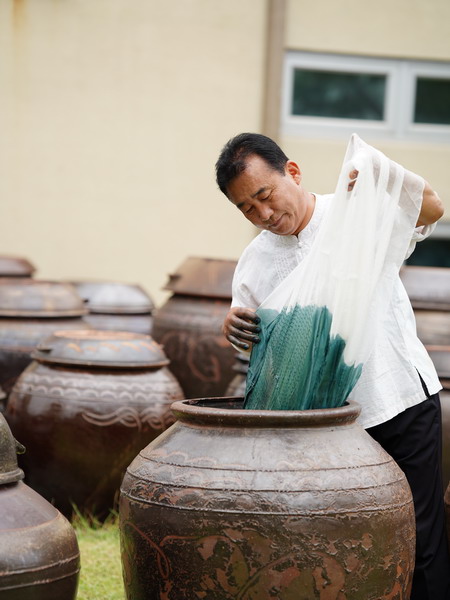
Jennis: Jjok is called the thousand-year-old color. How did it get that moniker?
Master Jung: A Chinese scholar named Xunzi (순자, 298–235 B.C.) is said to have coined the phrase “Cheong-chul-eo-ram” (靑出於藍, 청출어람). It means that if a disciple studies hard enough, they can surpass their master in knowledge. It derives from the saying “Just as blue is bluer than the jjok from which it comes, and ice is colder than the water from which it comes, a disciple can become wiser than the master with whom they study.” This suggests that the principle of dyeing was already known and used over 2,000 years ago. In Korea, Buddhist scriptures written during the Goryeo Dynasty and preserved with jjok have remained extant for a thousand years.
Jennis: What would you say the advantages are of jjok dyeing?
Master Jung: I think it is very meaningful to dye using natural dye instead of chemical dye. These days, people are increasingly aware of the need to preserve nature and pass on a clean environment to future generations. Jjok dyeing has an antibacterial function, so some people with skin conditions like to wear naturally dyed undergarments. And of course, keeping the craft of jjok dyeing alive preserves one of our valuable Korean traditions.

Jennis: Would you let me know what plans you might have for the future?
Master Jung: I think it is my calling to take old traditions and transform them into new culture suitable for the present era. It is my wish that many people use our traditional dyes and dyeing methods, which make for a healthy life, instead of using chemical dyes that pollute the environment. I am looking forward to the day when people wear jjok-dyed blue jeans.
Jennis: Wow, that is an amazing idea! Save the earth while wearing environmentally friendly jjok-dyed blue jeans. I hope to see people in traditional jjok-dyed blue jeans walking down the streets across the globe someday – you could call them “jjok-jeans”! Thank you, Master Jung. I appreciate you giving up so much of your precious time for this interview.
Photographs courtesy of Jung Kwan-chae.
Master Jung’s Traditional Dyeing Facility & Training Center / 염색장 전수교육관
Address: 571 Musuk-ro (Gaheung-ri), Dasi-myeon, Naju, Jeollanam-do
전남 나주시 다시면 (가흥리) 무숙로 571
Phone: 061-332-5359
Website: http://www.jungindigo.com/
The Interviewer
Kang Jennis Hyunsuk is a freelance interpreter who loves to read books and grow greens. She has lived in Gwangju all her life and is most certainly a lover of the City of Light.







